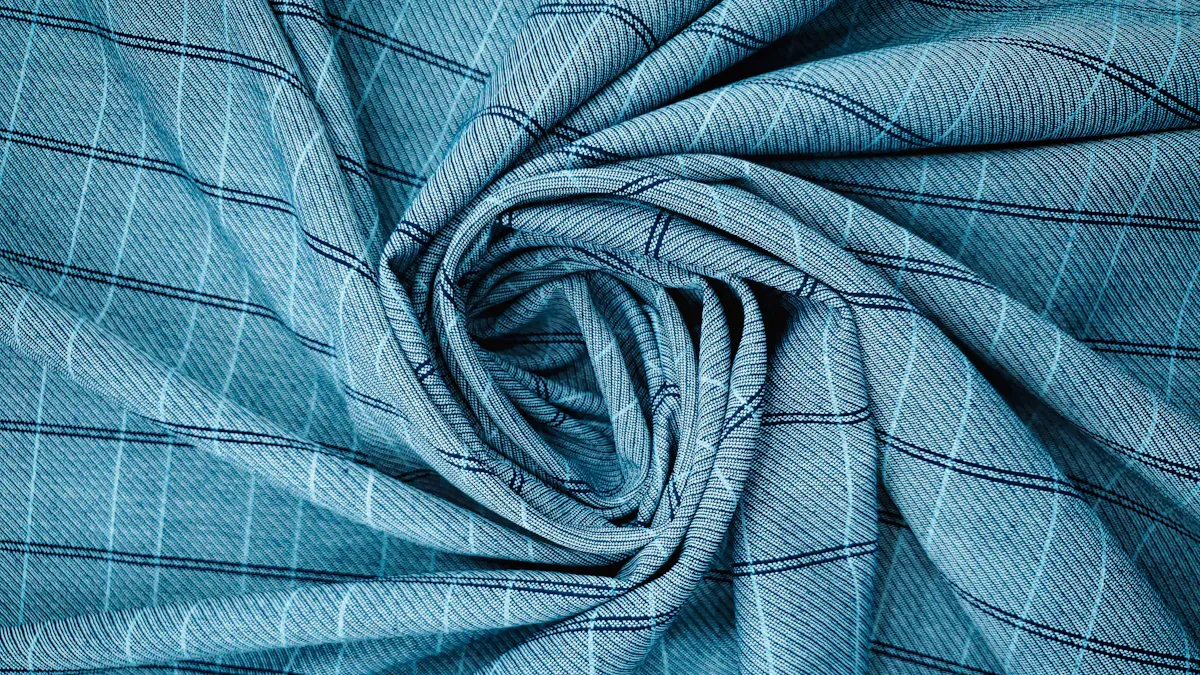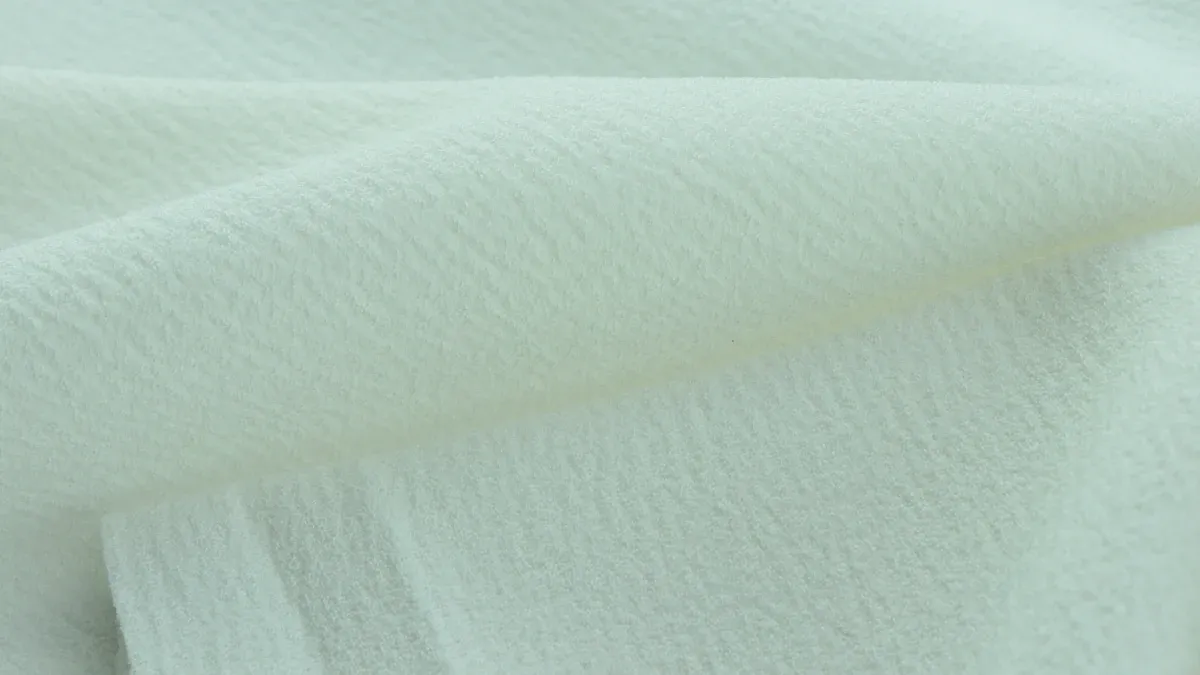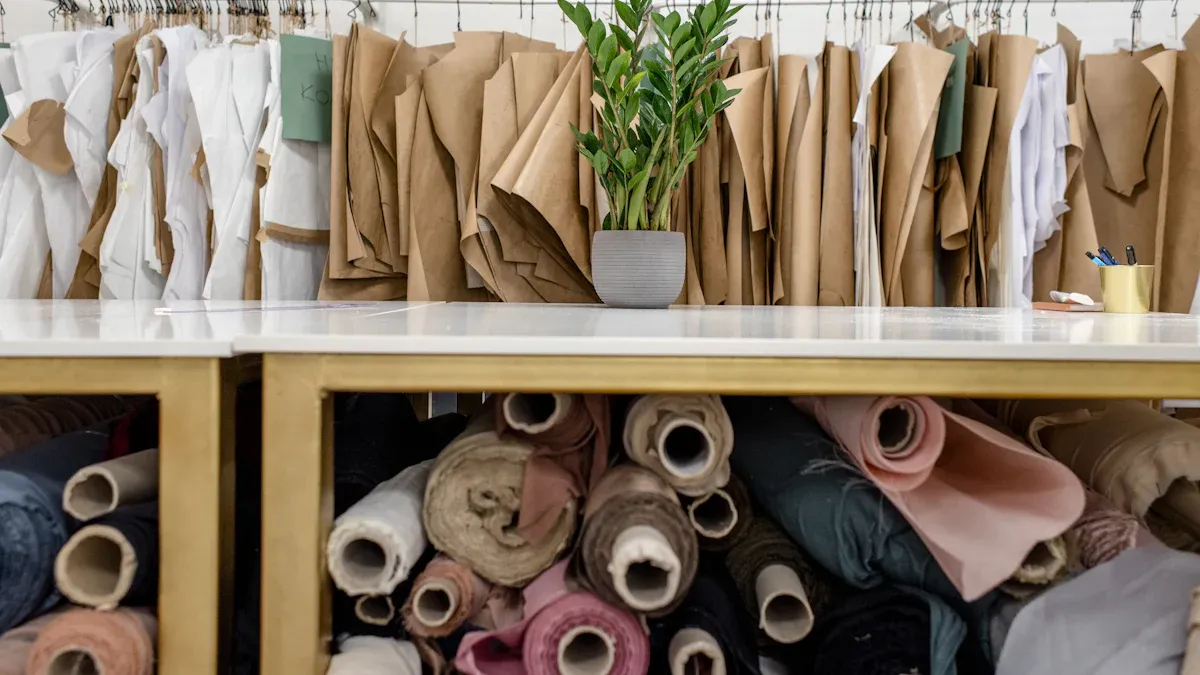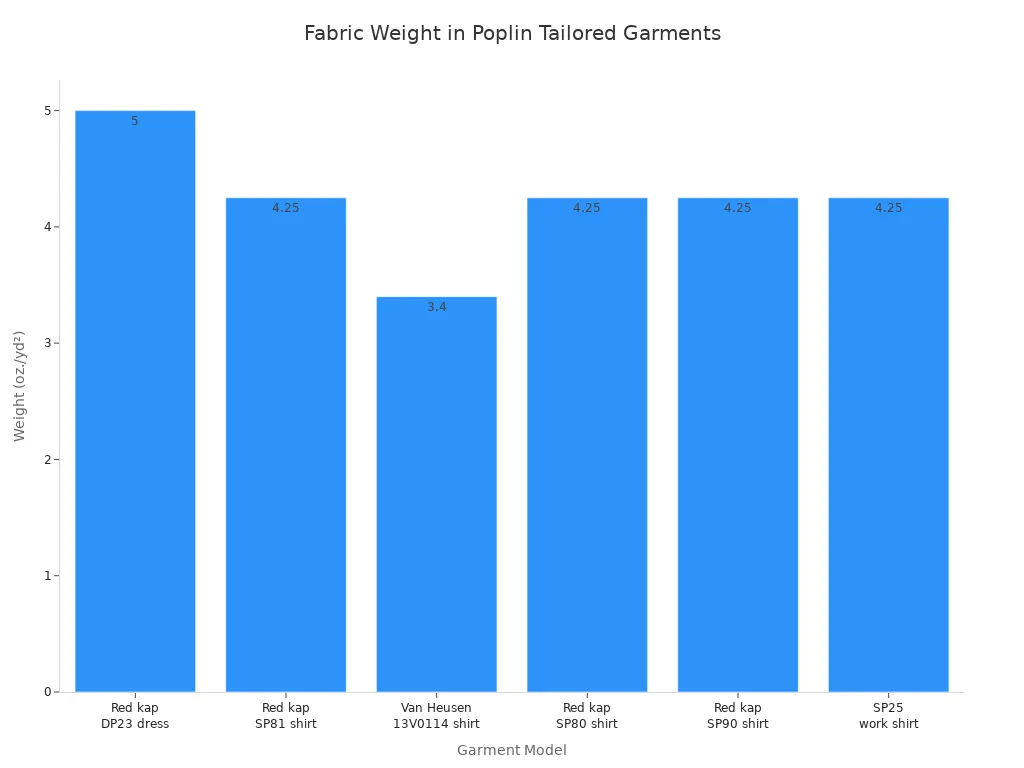
What is poplin cotton? Poplin cotton is a smooth, tightly woven cotton fabric known for its crisp, lightweight, and cool feel against the skin. If you’ve ever asked what poplin cotton is and why it’s popular in so many modern sewing projects, it’s because of its perfect blend of comfort and durability.
Poplin cotton holds its shape well, resists wrinkles, and is ideal for a variety of uses, from shirts to home décor. Here’s why poplin cotton might be the perfect choice for your next project:
The fabric is thin, breathable, and dries quickly.
Poplin cotton’s surface stays flat and sleek, making it perfect for vibrant prints and crisp pleats.
Cotton poplin absorbs moisture, feels gentle on sensitive skin, and dyes beautifully.
Available in many colors and patterns, Fanda Fabrics offers an excellent selection of poplin cotton to suit any sewing idea you have.
Key Takeaways
Poplin cotton is a smooth, lightweight fabric with a tight weave that feels crisp, cool, and comfortable against the skin.
Its unique structure makes poplin durable, wrinkle-resistant, and perfect for shirts, dresses, quilting, and home décor projects.
Poplin cotton holds its shape well and comes in many colors and blends, including 100% cotton and cotton-polyester mixes for different needs.
Caring for poplin is easy: wash gently in cold or warm water, air dry or tumble dry low, and iron while damp to keep it looking fresh.
Fanda Fabrics offers a wide selection of poplin cotton with customization options, making it a versatile choice for modern sewing projects.
What is Poplin Cotton?

Poplin Fabric Origins
When you ask, “What is poplin cotton?” you might be surprised by its rich history. Poplin fabric first appeared in 15th-century Avignon, France. People called it ‘papelino’ back then, a name inspired by the papal residence in the city. This connection to the papacy led many to refer to it as ‘papal linen.’
Some stories also link the name to Poperinge, a Flemish town famous for its textile production. Over time, the word evolved through French and English, picking up influences from both languages and even a bit of folk etymology involving the word ‘pope.’
Poplin started as a fabric made from silk, wool, or cotton blends. People used it for elegant dresses and upholstery.
By the 19th century, cotton became the main fiber, making poplin lighter and more versatile.
During World War II, poplin cotton became a favorite for military uniforms because of its comfort and durability.
After the war, poplin moved into everyday fashion, showing up in shirts, dresses, and even home décor.
Today, you’ll find poplin fabric made from cotton, polyester, or blends, but cotton poplin remains a top choice for its breathability and softness.
You can see how poplin cotton has adapted over the centuries, always keeping its reputation for quality and versatility.
Poplin Cotton Structure
Now, let’s look at what makes poplin cotton unique. When you touch poplin fabric, you’ll notice its smooth, crisp feel. This comes from the way manufacturers weave the threads. Poplin uses a plain weave, but it stands out because of its unbalanced structure.
The warp threads (the ones running lengthwise) are much finer and more tightly packed than the weft threads (the ones running across). Usually, the ratio of warp to weft density sits around 1.8 to 2.2:1. This means you get a fabric with a tight, dense weave and a subtle ribbed texture.
Poplin cotton fabric often features a thread count of about 205, which gives it that signature smoothness and durability. Some poplin cotton fabrics use 100% cotton, including high-quality types like pima cotton. The combination of fine warp yarns and thicker weft yarns creates a surface with diamond-shaped grains and a clean, flat appearance. This structure makes poplin different from other plain weave fabrics, which usually have more balanced yarn thickness and density.
Tip: If you want a fabric that holds its shape, feels cool, and looks polished, cotton poplin is a fantastic choice for shirts, dresses, and even quilting projects.
Poplin’s structure also gives it a slight sheen and a crisp hand feel. Compared to other cotton weaves like voile or batiste, poplin feels denser and a bit heavier, but it still drapes beautifully. This balance of durability, structure, and comfort is why so many sewists love working with poplin cotton.
Poplin Cotton Weave
Cotton Poplin Fabric Construction
When you look closely at poplin fabric, you’ll notice its smooth, crisp surface. That comes from the way you weave cotton poplin fabric. You use a plain weave technique, which means you interlace the warp and weft threads in a simple over-under pattern.
The magic happens because the warp threads are finer and more tightly packed than the weft threads. This gives poplin fabric its signature ribbed texture and a surface that feels both soft and sturdy.
You’ll find that cotton poplin stands out from other plain weave cotton fabric because of this unique structure. The heavier weft yarns and the dense arrangement of warp threads create a fabric that holds its shape and resists wrinkles.
Modern weaving uses high-speed looms with computerized tension control, so you get consistent quality every time. If you want a fabric that feels crisp, looks polished, and lasts through many washes, cotton poplin is a great choice.
Tip: Poplin fabric’s tight weave makes it perfect for dress shirts, blouses, and even stretch poplin fabric for fitted styles. You get a fabric that’s breathable, smooth, and easy to sew.
Poplin fabric is also a smart pick if you care about sustainability. Organic cotton poplin uses a field-to-loom process without chemicals, so you get a natural, bright, and eco-friendly fabric.
Poplin Lining and CVC Poplin
You might wonder how poplin lining and CVC poplin compare to standard cotton poplin. Poplin lining fabric usually blends 65% polyester with 35% cotton. This mix gives you a lightweight, durable fabric that works well for lining jackets, dresses, and uniforms. It’s smooth, resists wear, and adds structure without bulk.
CVC poplin fabric blends about 55% cotton with 45% polyester. You get the comfort and breathability of cotton, plus the durability and wrinkle resistance of polyester. This makes CVC poplin fabric a smart choice for uniforms, workwear, and any project where you want easy care and long-lasting wear.
Standard cotton poplin, on the other hand, is 100% cotton. It absorbs moisture better and feels softer, but it may cost a bit more and isn’t quite as tough as CVC poplin.
Here’s a quick comparison:
Type | Composition | Best For | Key Benefits |
|---|---|---|---|
Cotton Poplin | 100% cotton | Shirts, dresses, crafts | Soft, breathable, absorbent |
CVC Poplin | 55% cotton, 45% poly | Uniforms, workwear | Durable, easy care, comfy |
Poplin Lining | 65% poly, 35% cotton | Linings, pockets | Lightweight, strong, smooth |
Poplin fabric gives you options for every sewing need, whether you want pure cotton comfort or a blend that stands up to daily use.
Poplin Cotton vs Other Fabrics
Poplin vs Regular Cotton
When you compare poplin fabric to regular cotton, you’ll notice some big differences in how they look and feel. Poplin stands out because of its tight, plain weave.
This gives poplin fabric a smooth, slightly crisp texture that feels soft but holds its shape. Regular cotton can feel soft and cozy, but the texture and weight change a lot depending on the weave.
Here’s a quick table to help you see the differences:
Attribute | Poplin Cotton Fabric | Regular Cotton Fabric |
|---|---|---|
Texture | Smooth, slightly crisp, and durable due to tight plain weave; slightly stiff yet soft and smooth finish | Varies widely depending on weave and processing; generally soft and breathable |
Weight | Medium-weight; denser and slightly heavier than some other cotton fabrics; balances structure and comfort | Varies greatly; can range from lightweight to heavy depending on fabric type |
Breathability | Breathable due to cotton fiber and plain weave, though a tighter weave adds durability and a polished look | Generally breathable and soft; breathability depends on weave and fabric type |
You’ll find that poplin fabric is more wrinkle-resistant than most regular cotton. The tight weave and fine threads help poplin keep its crisp look, even after a long day. Regular cotton, especially in looser weaves, tends to wrinkle more easily. If you want a shirt that looks sharp with less ironing, poplin is a smart pick.
Poplin fabric uses a specific weave for a smooth, crisp finish.
Regular cotton comes in many weaves and textures, often softer but more likely to wrinkle.
Poplin’s tight weave makes it great for formal shirts and dresses.
Regular cotton is perfect for casual wear but creases more.
If you’re deciding between poplin vs cotton for your next project, think about the look and feel you want. Poplin fabric gives you a polished, structured style, while regular cotton offers softness and comfort.
Poplin vs Twill and Linen
You might wonder how poplin compares to twill and linen. Each fabric has its own strengths, so your choice depends on your project.
Fabric | Weave Characteristics | Feel & Texture | Weight | Shine | Typical Applications | Pros | Cons |
|---|---|---|---|---|---|---|---|
Poplin | Plain weave, smooth, no texture | Thin, smooth, silky, soft | Lightweight | Minimal | Summer office wear, casual events | Comfortable for summer | Wrinkles easily, slight transparency |
Twill | Distinctive diagonal weave | Soft, noticeable diagonal texture | Slightly heavier than poplin | Slight | Cooler weather office wear, casual events | Crease-resistant, versatile | Heavier than other fabrics |
Linen | Derived from flax, natural weave | Lightweight, breathable, textured | Lightweight | Natural matte | Hot weather, casual and relaxed looks | Breathable, ideal for heat | Wrinkles easily |
Poplin fabric feels smooth and light, making it perfect for warm weather and office wear. Twill has a diagonal weave, so it feels heavier and resists creasing. Linen is super breathable and great for hot days, but it wrinkles fast.
If you want something affordable, poplin cotton usually costs less than twill or linen. Many brands choose poplin for stylish, comfortable clothes that don’t break the bank.
Tip: If you want a crisp, polished look for summer, poplin fabric is your go-to. For cooler weather or a more textured feel, try twill. For ultimate breathability, linen is hard to beat.
Poplin Cotton Properties
Texture and Feel
When you touch poplin, you’ll notice how smooth and crisp it feels. Poplin fabric stands out because it combines a soft hand with a subtle sheen, giving your projects a polished look. The surface feels almost silky, but you still get that satisfying crispness that makes shirts and dresses look sharp.
Compared to other cotton fabrics, poplin is the smoothest and lightest. You get a cool, breathable texture that feels great against your skin, especially in warm weather.
Here’s a quick comparison to help you see how poplin stacks up:
Fabric Type | Texture & Feel |
|---|---|
Poplin (Broadcloth) | Very soft, smooth, crisp, subtle sheen |
Oxford | Thicker, rougher, less crisp |
Twill | Softer, thicker, less cool |
Cotton Lawn | Airy, soft, crisp, more delicate |
Poplin’s lightweight weave lets air flow easily, so you stay comfortable even on hot days. You’ll love how cotton poplin drapes beautifully for both apparel and home décor. If you want a fabric that feels fresh, looks refined, and is easy to sew, poplin is a top pick.
Tip: Poplin’s breathability and moisture-wicking properties make it perfect for summer shirts, dresses, and lightweight bottoms.
Durability and Care
Poplin fabric isn’t just about good looks—it’s tough, too. The tight weave gives you a fabric that holds its shape and stands up to daily wear. You can count on poplin to resist pilling and tearing, so your clothes and crafts last longer.
If you choose 100% cotton poplin, you get natural strength and comfort, while blends add even more resilience.
Taking care of poplin is simple. Just follow these steps:
Wash poplin on a gentle cycle in cold or warm water to avoid shrinkage.
Use mild detergent and skip harsh chemicals.
Air dry or use a low tumble-dry setting to keep the fabric crisp.
Iron while slightly damp for best results—medium heat works well.
Poplin is easy to maintain, so you spend less time worrying about wrinkles or fading. Store your cotton poplin garments in a cool, dry place, and they’ll keep their shape and color for years. These properties of poplin fabric make it a favorite for busy sewists who want style and durability. The benefits of poplin fabric really shine when you need something that looks great and lasts.
Uses of Poplin Cotton

Apparel and Fashion
You see poplin everywhere in fashion. This fabric gives you a crisp, polished look that works for both formal and casual summer attire. If you want a high-quality dress shirt, poplin fabric is a top pick.
You get a smooth finish that feels cool and comfortable, even on hot days. Many designers use cotton poplin for tailored clothing because it holds its shape and resists wrinkles.
Here are some popular garments made from poplin cotton:
Dress shirts
Blouses (including the classic poplin blouse)
Dresses (like a breezy poplin dress)
Skirts
Trousers
Poplin pajama pants
Other tailored pieces
Poplin fabric blends, like CVC poplin, also shine in uniforms and workwear. You get durability, easy care, and a crisp look that lasts all day. Take a look at how poplin performs in tailored garments:
Garment Model | Fabric Composition | Weight (oz./yd²) | Key Tailored Features | Performance Attributes |
|---|---|---|---|---|
Red Kap DP23 women’s short-sleeved dress | 80/20 polyester/cotton | 5 | One-piece lined button front, princess seams, two pockets | Durable, wrinkle-resistant |
Red Kap SP81 women’s dress shirt | 65/35 polyester/cotton | 4.25 | No pocket, seven woodtone buttons | Lightweight, wrinkle-resistant |
Van Heusen 13V0114 women’s silky poplin shirt | 60/40 cotton/polyester | 3.4 | Soft-fused collar, narrow placket, pearlized cuff buttons | Wrinkle-free, smooth, crisp appearance |
Red Kap SP80 poplin short-sleeve dress shirt | 65/35 polyester/cotton | 4.25 | Button-down collar, box-pleated back, longer body | Soil-release, durable press, wickable finish |
Red Kap SP90 poplin dress shirt | 65/35 polyester/cotton | 4.25 | Button-down collar, box-pleated back, longer body | Soil-release, durable press, wickable finish |
SP25 women’s short-sleeved pocketless work shirt | 65/35 polyester/cotton | 4.25 | Two-piece lined stays, stitched-down front | Durable press, soil release, wickable finish |

You can see how poplin fabric blends offer lightweight comfort, wrinkle resistance, and a crisp look for everyday wear.
Quilting and Home Décor
Poplin fabric is not just for clothing. You can use cotton poplin in quilting and home décor projects, too. The smooth, flat surface and slight sheen make your quilts look neat and professional. Poplin’s tight weave keeps it from fraying, so you get clean edges and long-lasting results.
You might choose poplin for accent pillows, curtains, or napkins. The fabric’s durability means your home décor items will stand up to daily use and frequent washing. Poplin’s crispness gives curtains and pillow covers a structured, tailored look. You also get breathability, which keeps your home textiles comfortable.
Here’s why poplin works so well for home projects:
Smooth texture and durability for curtains and pillow covers
Crisp lines for a structured appearance
Breathable comfort for everyday use
Easy care and wrinkle resistance, especially in blends
If you love sewing, you’ll find poplin fabric easy to handle. It’s a favorite for both beginners and experienced sewists.
Fanda Fabrics Poplin Selection
Fanda Fabrics gives you a wide range of poplin fabric options for any project. You can pick from Cotton Poplin, CVC Poplin, Poplin Lining, and Woven Poplin. These fabrics work great for tailored shirts, poplin blouses, poplin dresses, skirts, suit linings, and even poplin pajama pants.
You can also use them for quilting, crafting, and home décor.
Modern sewing projects often feature Fanda Fabrics’ poplin for its smooth surface, crisp drape, and ability to hold vibrant prints. You can create custom office wear, casual outfits, or unique home accents. Poplin’s printability and durability make it perfect for promotional items, too.
Fanda Fabrics lets you customize your poplin fabric. You can choose different weights, colors, finishes, and even specialty treatments like water resistance or fire retardancy.
The company offers digital and screen printing for bold designs. You can order custom widths and lengths to fit your needs. Fanda Fabrics also provides Oeko-Tex and GOTS certifications, so you know your cotton poplin meets high environmental and safety standards.
Tip: If you want a fabric that fits your vision, ask Fanda Fabrics about their customization options. You can get the perfect poplin for any sewing project.
Conclusion
Poplin stands out as a crisp, smooth, and strong cotton that works for almost any sewing project. You get a fabric that feels soft, holds its shape, and looks polished. Poplin’s tight weave and subtle ribs give you comfort and durability. This cotton is easy to care for and comes in many colors and prints.
Fanda Fabrics offers a wide range of poplin, from classic cotton to blends, so you always find the right versatile fabric. When you pick poplin, check the weight, fiber blend, and care needs to match your project. Poplin cotton makes sewing fun and rewarding!
FAQ
What is the best way to pre-wash poplin cotton?
You should wash poplin cotton in cold or lukewarm water before sewing. This helps prevent shrinkage later. Use a gentle cycle and mild detergent. Air dry or tumble dry on low. Iron while slightly damp for the smoothest results.
Can you use poplin cotton for quilting?
Absolutely! Poplin cotton works great for quilting. Its smooth surface and tight weave make it easy to cut and sew. You get crisp lines and vibrant prints. Fanda Fabrics offers poplin in many colors and patterns, perfect for your next quilt.
Does poplin cotton wrinkle easily?
Poplin cotton resists wrinkles better than many other cotton fabrics. You might see some creasing, but it usually smooths out with a quick iron. Blended poplin, like CVC poplin, wrinkles even less and needs less ironing.
Is poplin cotton good for sensitive skin?
Yes, poplin cotton feels soft and gentle on your skin. It breathes well and absorbs moisture, so you stay comfortable. If you have sensitive skin, look for 100% cotton poplin from Fanda Fabrics for the best comfort.
Can I customize poplin cotton at Fanda Fabrics?
You sure can! Fanda Fabrics lets you choose colors, weights, finishes, and even special treatments like water resistance. You can also request certifications like Oeko-Tex or GOTS. Just ask about customization when you order.
